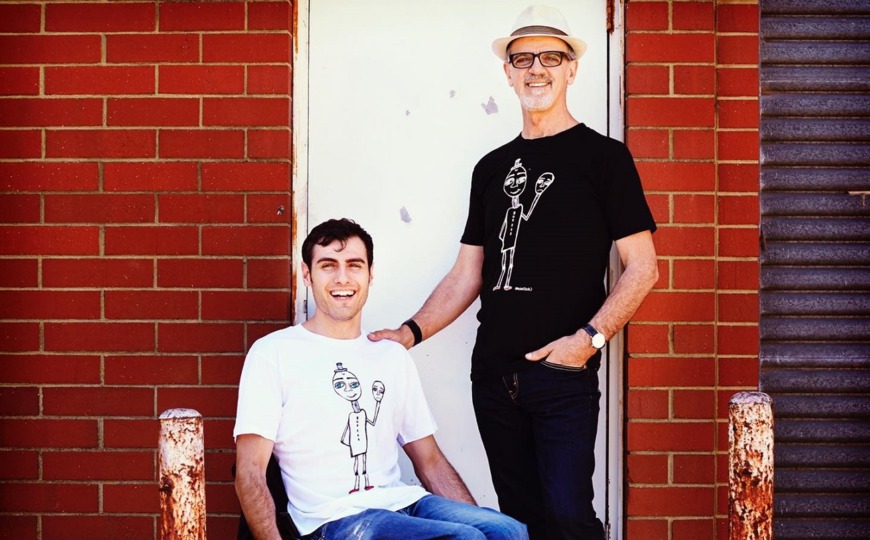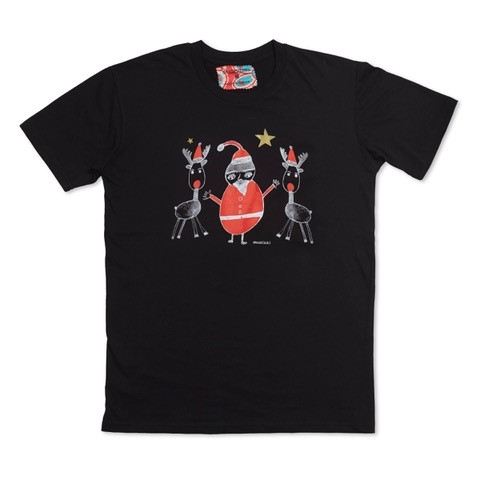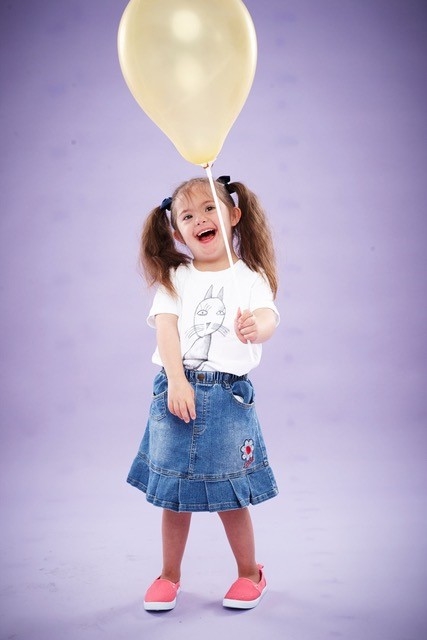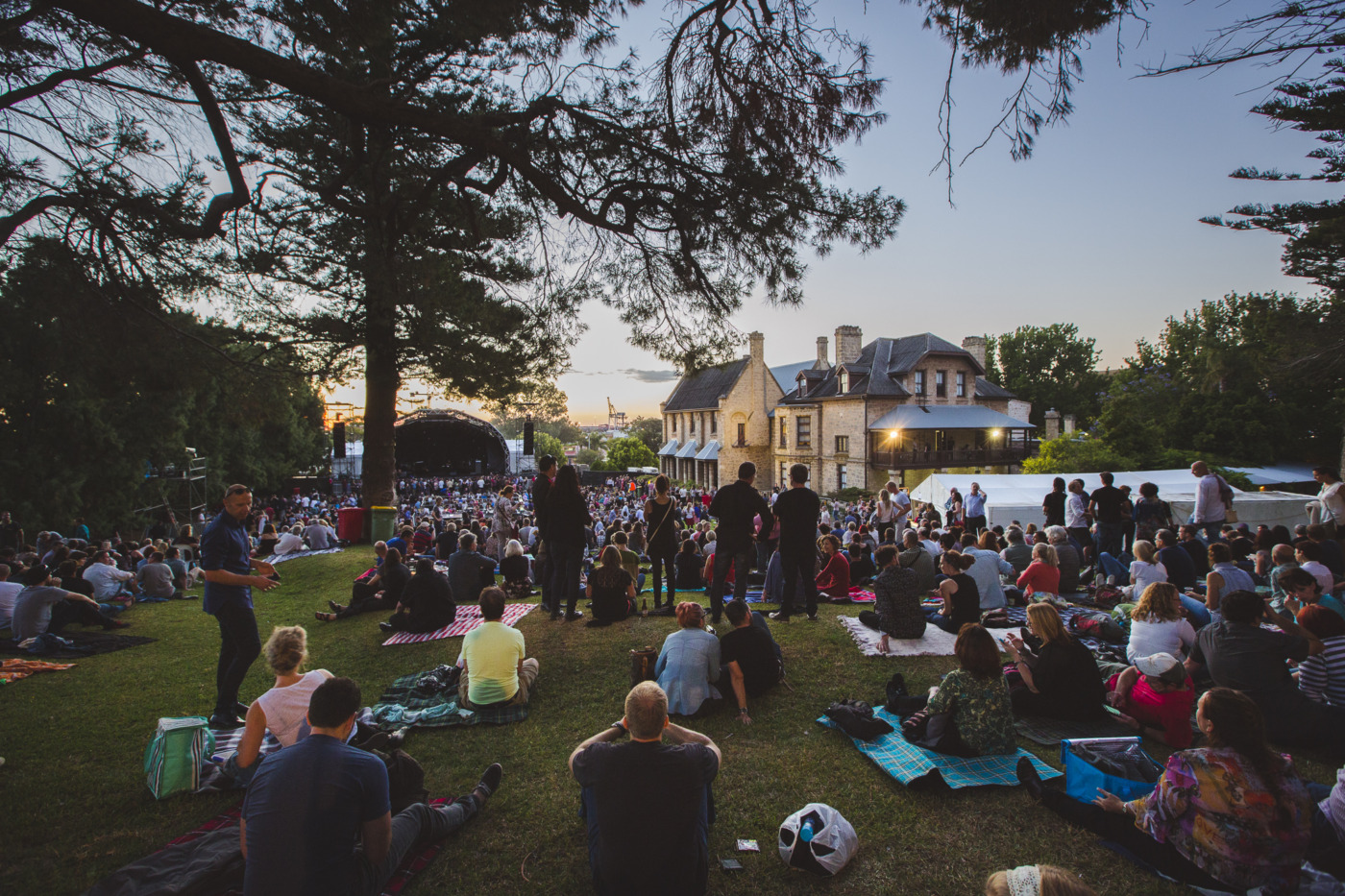Stall Name: Daniel(ink)
Website: shop.danielink.com.au
Instagram: @danielink_tshirts
Tell us a bit about yourself and what you’ll be selling?
My name is Daniel Pavlovic and I have a little t-shirt business! I design my t-shirts for everyone from babies to adults! My tees come in a range of black white or grey and in short or long sleeves. I’ve also started making embroidered hats and hoodies and prints of my illustrations.
I didn’t set out to be a t-shirt designer, I really wanted to be a comedian. I really loved art class in high school and went on to do a TAFE art course, I thought it would be a cool idea to put some of my designs on t-shirts. What started as a little stall at a local arts festival with my first design has grown into the many designs and different styles I have now. Daniel(ink.) has literally given me a whole new direction in life and a new focus. Did I mention I have Cerebral Palsy? CP affects the muscles in my legs and hands so don’t get me wrong, life may be a challenge, but I am enjoying that challenge!
How do you make the works?
I design my illustrations at my family home in the beautiful hills of Perth. These designs are then individually screen printed the old fashioned way onto 100% cotton t-shirts at a local business just around the corner. My grandmother then helps hand stitch my labels onto each tee, she’s in her 80s now but still wants to help out! My Dad, my Mum and my sister also help me out, so it’s a real family affair.
Why is it important to support local makers?
We’ve all got to help each other out, especially with everything that’s happening in the world at the moment. Buying things made by locals is a small thing we can do that means a lot to someone else.
What’s your top gift tip this Christmas?
Getting people’s artwork as gifts is a great idea, art makes people happy and can brighten up anything. If you’re after something Christmas-themed I’ve designed a special Christmas tee with an added gold star and there’s one for the whole family!
Bazaar runs 5–9pm Fri 4 Dec | 9am–5pm Sat 5 & Sun 6 Dec
Opening 6:30pm Fri 25 Sep, Bodywork boldly reclaims the female body with works from three rising stars of Australia’s art world – Kaylene Whiskey (SA), Amber Boardman (NSW), and Tarryn Gill (WA). Featuring contorted soft sculptures, a video collage of female celebrity icons, and fleshy paintings, Bodywork explores ideas connected to body modification, self-expression and female empowerment.
We recently caught up with Perth artist Tarryn Gill to find out more about her practice and the large-scale sculptures she’s been busy creating for the exhibition.
Hi Tarryn, are you able to tell us about your art practice?
I’ve been working as an artist since I graduated from Curtin Art School in 2001. For the first ten years, I worked predominantly in collaborations making photographs, films and performances. Since then I have focused on a solo studio-based practice and have been making mostly sculptural works. I also work occasionally in theatre as a designer.
Can you tell us about your works in Bodywork?
I’ve made two new series of works for Bodywork. Limber is a group of three soft sculptures originally inspired by trees in Java that left me in awe. The trees felt powerful in a matriarchal way and I related their limbs to my own. With the Bodywork show in mind, I began the Limber designs using shapes I used to make with my own body in calisthenics. I imagined them growing, becoming enormous, strong, and powerful. I wanted them to resist sexualisation with their uncanny scale and have them meet the eye of the viewer. I used the title Limber thinking about personal growth, having a supple and resilient quality of both the mind and body.
Show Girl is a smaller series of works which I’m calling ‘soft reliefs’ because they are wall-mounted sculptures made from foam and fabric in which the three-dimensional elements are raised from a flat base. They are a small collection of depictions of moments in cinema that shaped who I am today. They are all fondly rendered scenes from musicals & feature the performance of femininity – iconic figures that served as role models early in my life. They informed my aesthetic interests and fuelled my desire to become a performer.
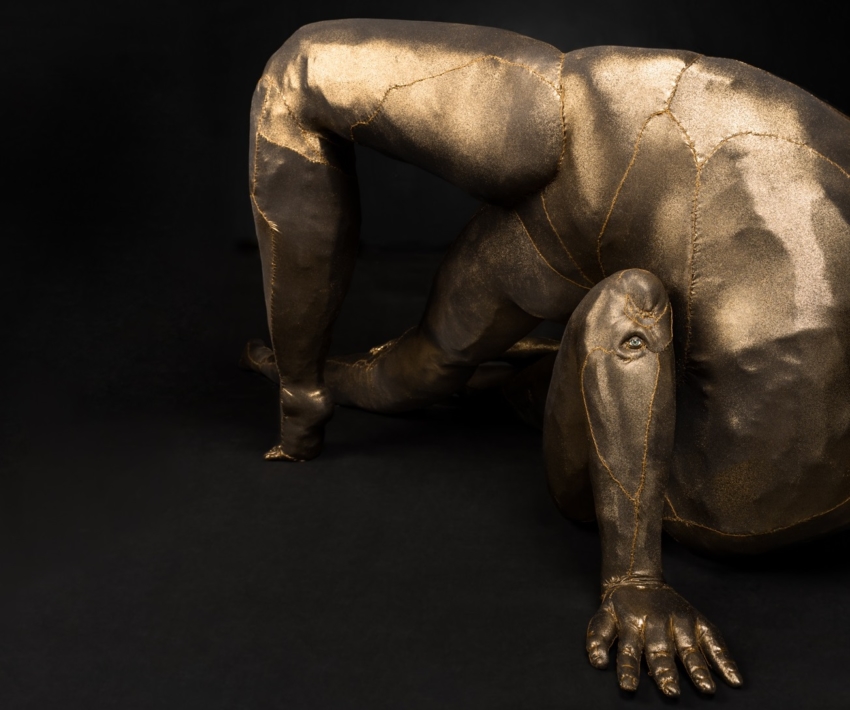
Tarryn Gill, Limber (1), 2020, mixed media, including hand-stitched Lycra, EPE foam and fibre fill, artificial eyes, steel, dimensions: 1.1m x 3.7m x 1.25m. Courtesy of the artist and Gallery Sally Dan-Cuthbert. Photograph by Pixel Poetry
These are your largest works to date. What inspired the move into such large-scale sculpture?
I’ve wanted to make large scale works for some time because I’m interested in making experiential spaces for the audience – if you as a human can feel small it’s a way to experience awe. To make work of this scale you really need support. I am grateful to have been supported financially by DLGSC (Department of Local Government, Sport and Cultural Industries) to cover the materials and labour, Erin Coates and Fremantle Arts Centre have given me the platform and a large space to exhibit work at this scale! Also, I am currently lucky enough to have a studio space big enough.
You hand-stitch and carve all your works. How long did each sculpture take you to make?
I’ve been working on these part-time since the beginning of 2020 – but I’d estimate the Limber sculptures took me around six weeks each in total. The hand-sewing process is slow and because of the scale it takes a lot of physical energy to get around them – at times I was sewing up a step ladder or sewing laying on my back underneath them. It felt like I was definitely pushing the limits of what my body can do!
You use sparkly materials commonly used in dance and theatre costumes – what draws you to those?
I have loved musicals and musical theatre since I was very young and I performed in calisthenics for 20 years – from when I was 5-25. The costumes we wore were a huge part of the excitement for me and when I began making soft sculptures, I cut up some of my old costumes to make them. I have found these materials which are usually dismissed as ‘girly’ or ‘infantile’ can be taken out of context to create works that are darkly powerful.
Tell us about your interest in the uncanny female body.
I’m interested in the way the uncanny is a short-cut to the unconscious and I’ve been thinking about the female uncanny body as a way to evoke narratives around personal change and transformation.
How many limbs and eyeballs feature in your Limber sculptures in Bodywork?
Five eyeballs and 17 limbs (I think!)
Tarryn Gill, Limber (1) (detail), 2020, mixed media, including hand-stitched Lycra, EPE foam and fibre fill, artificial eyes, steel, dimensions: 1.1m x 3.7m x 1.25m. Courtesy of the artist and Gallery Sally Dan-Cuthbert. Photograph by Pixel Poetry
What to see more of Tarryn’s work? Visit her Instagram and website.
Bodywork opens 6:30pm Fri 25 Sep
RSVP to attend the opening and find out more about the exhibition.
Maruku Arts meaning ‘belonging to black’ is owned and operated by Anangu people from the Western and Central Deserts of Australia. As one of the largest art centres, approximately 900 Anangu artists are part of the collective. Artists at Maruku are particularly well known for their punu (living wood) – expertly carved wooden objects. Maruku aims to share knowledge with future generations of artists and make culture accessible in an authentic way for those that seek a more in-depth understanding. Traditional punu-making has been passed down from generation to generation for thousands of years. Punu are not made only as artefacts, but as living expressions of Country.
For the Revealed Exhibition, a group of Minyma Yarnangu women from the Pitjantjatjara and Ngaanyatjarra speaking Western Desert area handcrafted sleek and contemporary wooden objects. A selection of wana (digging sticks) have been created to showcase tools of old that were traditionally used in the time before the invasion of Aboriginal land. These works showcase simple and sophisticated use of materials, textures, and mark-making.
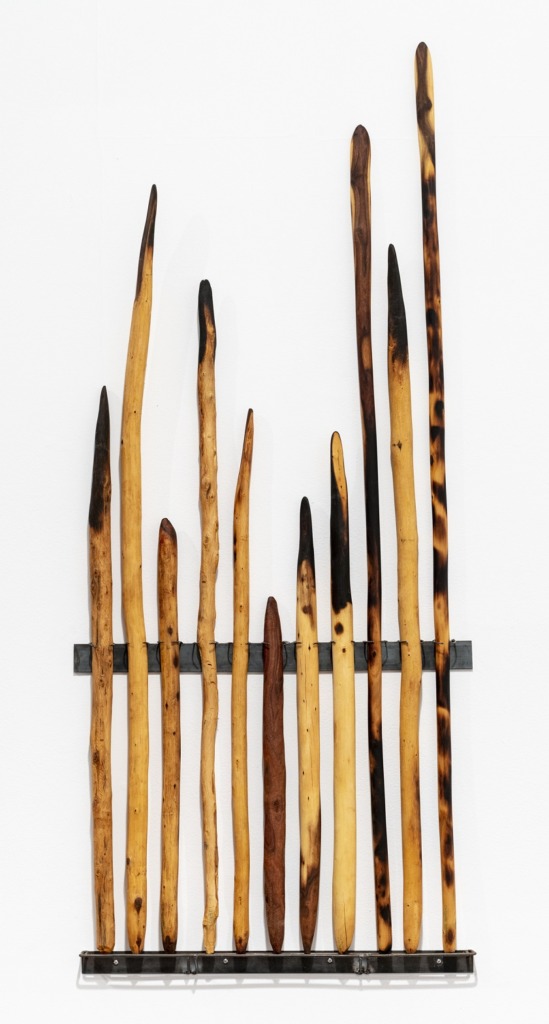
Various Works by Maruku Artists – Elizabeth Holland, Debra West, Nancy Carnegie, Ruth Bates, Sally Anne Foster, Adele Jennings, and Lynette Smith. Image courtesy of Maruku Arts. Photography by Pixel Poetry.
Alongside wana, a series bowls known as of piti, wiras and mimpus form part of the art centre’s Revealed offering. These bowls revive old traditions. Their shape responds to the structure of the wood and the marks reflect forms and patterns found in nature. With the arrival of white people and the cattle industry, fencing wire entered the Anangu world and was used to decorate wood carvings, giving bowls and other works ever since. Details which were previously drawn in the sand or painted on rocks or bodies are now burnt into the wood’s surface.
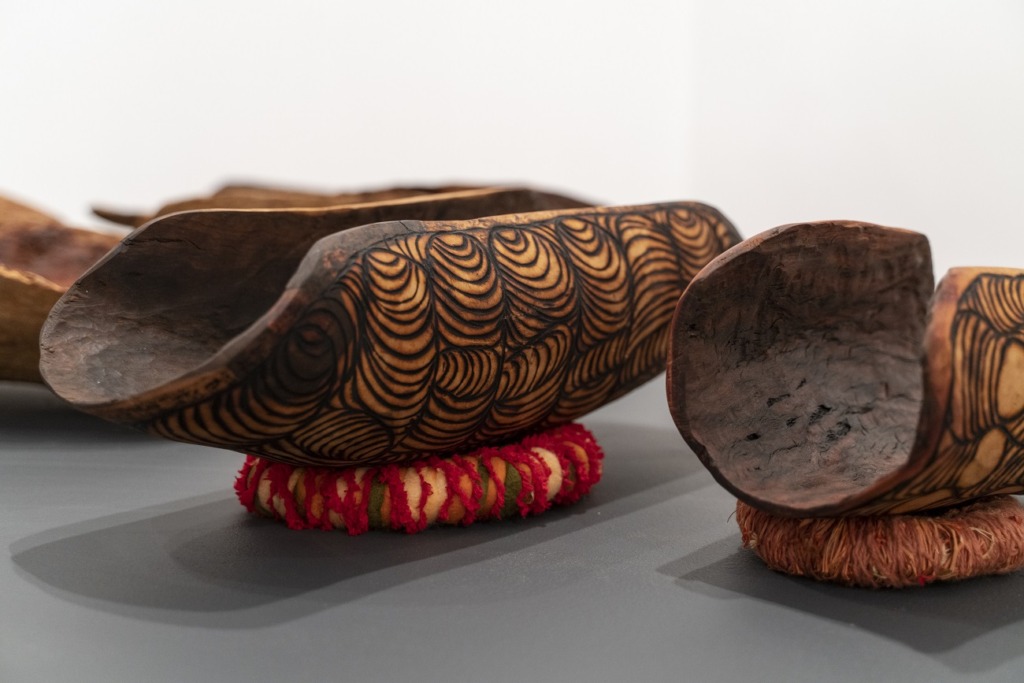
Debbie Nelson, Piti – Collecting Bowl, 2019, Kataya – limestone wattle 51 x 19 x 16 cm. Image courtesy of Maruku Arts. Photography by Pixel Poetry.
Maruku Arts | Revealed 2020 Artists: Prudence Mitchell, Sally Anne Foster, Corinne Shepherd, Debbie Nelson, Melissa Holland, Lynette Smith, Katie Brown, Adele Jennings, Delilah Shepard, Jodie West, Donna Porter, Lillian Golding, Ruth Bates Ward, Debra West, Angkaliya Mitchell, Elizabeth Holland, Chriselda Farmer, Lena Dawson, Nancy Carnegie
